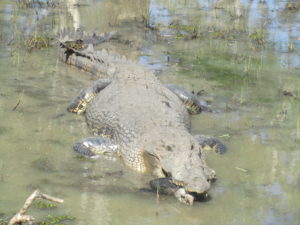25 July 2018
With a fearsome reputation as a ‘hypercarnivorous apex predator’, you would expect estuarine crocodiles (or ‘salties’ as we call them here in the north) to eat anything and everything that comes their way. But where do salties really get their nutrition from?
A new paper and research story from a NERP Northern Hub project led by Griffith University’s Australian Rivers Institute in collaboration with Parks Australia and NESP, attempts to answer this question for crocodiles in Kakadu National Park. Griffith University researcher Dr Fernanda Adame said the study used a combination of stable isotope measurements and direct feeding observations to show that crocodiles get much of their nutrition from terrestrial prey—mostly feral animals like buffalo and especially pigs. This was particularly true in the dry season when crocodiles are concentrated in shrinking waterholes that terrestrial animals depend on for drinking water. In the wet season, when crocodiles can move into the rivers and ocean, some were getting their nutrition from aquatic animals like fish and turtles—highlighting the importance of flows and connections between rivers and their estuaries and floodplains. Project leader Professor Stuart Bunn, Director of the Australian Rivers Institute, is now leading a NESP Hub project investigating the flows needed to sustain freshwater ecosystems in Queensland’s Mitchell River catchment.

A 3.3m croc finishing its meal of a feral pig in Magela Creek, Kakadu. Photo: Parks Australia.
Want to know more about the Resilient Landscapes Hub's activities and our research into practical solutions to environmental problems? Stay informed about activities, research, publications, events and more through the Hub newsletter.